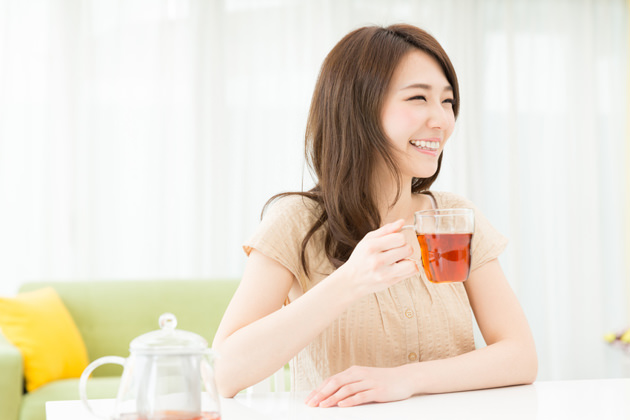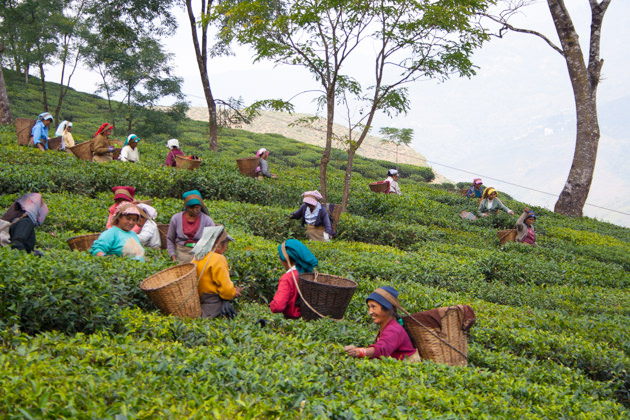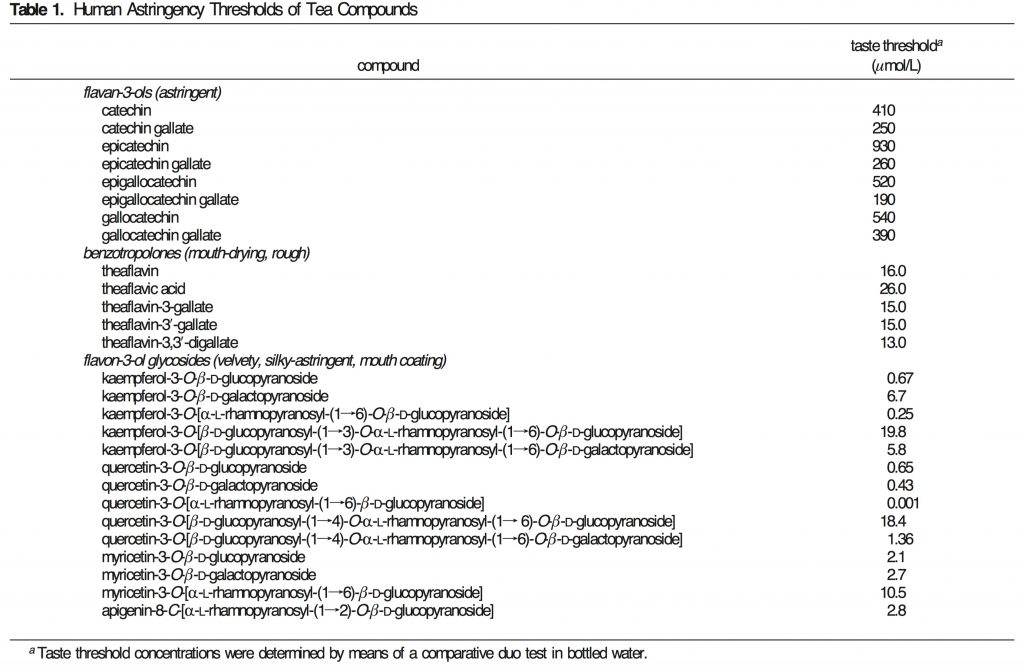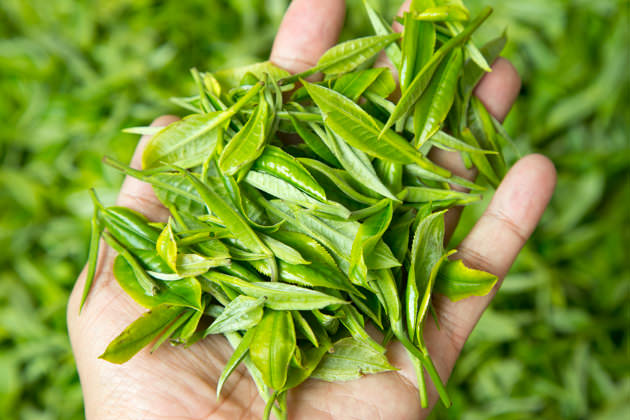- HOME >
- How to choose quality tea
The true reason why some pu-erh and black tea causes stomachache

We noticed that there are a number of customers who refrain from black tea or raw pu-erh tea due to the uncomforted stomach. I too have had the same experience that I suffered from stomachache after drinking some black tea. However, it has nothing to do with black tea or raw pu-erh tea. If tea is not made of the right material, any type of tea will give the same uncomfortable effect. Nevertheless, if tea is made from the right material, we can feel free to enjoy any type of tea even when empty stomach.
It is summer tea that causes various problems
Based on our experience, the summer tea has strong astringency which tends to cause stomachache.
During warm season especially in summer, one type of specific substance is composed in tea. When this type of tealeaf is processed into any type of tea, it tastes very astringent and causes stomachache. Because of the same reason, Darjeeling Second Flush gives strong astringency too. If the tea is processed into ripe pu-erh tea or deeply roasted oolong, the astringency is neglectable.
I have experienced the same trend in natural herbs. In Japan, I often go to the mountain to collect natural herbs. In spring, those herbs give sweetish taste and very thick flavor. These herbs are available in summer too. However, it turns extremely bitter and astringent in summer. It is impossible to enjoy them in summer.
For making black tea or raw pu-erh tea, the best quality is the first spring crop. Usually the first spring crop gives very sweet taste with creamy and soft mouth-feel. It is absolutely not astringent. However, the black tea and raw pu-erh tea is often made of the late-plucked tea in summer. The taste of the second- and third-plucked tea is less creamy and not soft but it is still acceptable. After the forth-plucked tea onwards, tea has a noticeable level of astringency.
In China, the price for the first-plucked tea is twice as expensive as the second-plucked tea. The price of third- or forth-plucked tea is much lower. The first-plucked spring tea is very limited due to the high demand. In the famous tea production area, the tea plucking is carried out more than 10 times. That means there is less than 10% of chance for getting the first-plucked spring tea. Considering that the first-plucked tea has high demand in China, most of the black tea or raw pu-erh tea available in overseas is the late-plucked tea. That is the reason why many people have negative experience with black tea and raw pu-erh tea. If the tea is of the first spring crop, it gives no astringency at all and the effect to the stomach is very gentle, no matter how thick we brew tea or drinking even when stomach is empty.
The root cause of the astringency
Now the question is what substance in tea causes stomachache and astringency. We should be able to identify it if we investigate which substance is particularly increasing in summer tea. I found the data in the Japanese book “Science of Tea” written by Yamanishi, on page 22. It shows that towards summer Epigallocatechin gallate (EGCg) is particularly increasing.
They monitored 4 different types of tea. No.1 from the left is Yabukita cultivar, No.2 is Qing-xin-wu-long, No.3 is Benihomare cultivar and the last one is Assam variety from Sri Lanka. 春 means spring and 夏 means summer.
Another literature, B Schwarz, T Hofmann – European Food Research and Technology, October 2008, 227explains in the abstract that Epigallocatechin gallate has a strong binding ability with protein.
Susanne Scharbert , Nadine Holzmann , and Thomas Hofmann, J. Agric. Food Chem., 2004, 52 (11), pp 3498–3508 carried out the sensory study to identify the substance in tea that causes astringency. The table below indicates the taste threshold to various poly phenols. The data shows that Epigallocatechin gallate gives the strongest astringent effect. Based on the data, we should be able to conclude that Epigallocatechin gallate is the substance causing the astringency and stomachache.
The mechanism that EGCg causes the astringency
Our oral and stomach cavity is made of protein. If any substance is binding with this protein layer, it gives astringent taste and uncomforted feeling. Tea with milk gives least effect in astringency and to the stomach, because Epigallocatechin gallate has already been reacted by milk protein and it is no longer reactive.
As a conclusion, the astringency or uncomfortable feeling with the stomach has nothing to do with the process or type of tea but it is directly affected by the material. If those teas are made of the first-plucked spring tea, we will not experience any astringent taste or stomachache at all.
In HOJO’s black tea and pu-erh tea lineup, all teas are made of the first spring crop except some Darjeeling autumn tea and second flush tea.
Every year we constantly visit the tea production sites to select tea in order to make sure that teas is mellow and not astringent.
Related Articles
How to get the latest update on HOJO?
1. Follow Twitter, 2. Click "Like" on Facebook, and 3. Subscribe in newsletter. You can have the latest tea news from HOJO.
 Subscribe the Newsletter to enjoy the privileges
Subscribe the Newsletter to enjoy the privileges- You may receive a free sample upon purchase, or you may have the priority to purchase special products. So please remember to subscribe our newsletter as well as the social network.
- 2024 Dong Shan Raw Pu-erh Tea – Crafted with the Producer for Desired Quality
- We have released the 2024 cake of Dong Shan Raw Pu-erh Tea. Earlier, we offered the loose-leaf version from th …
- New Arrival of Akitsu Mumyoi and Nosaka Rough Clay Teapot
- A wide selection of teaware by Watanabe Tozo, a Sado-based artist of Mumyoi-yaki, has just arrived. This time, …
NEW ARTICLES
 2024 Dong Shan Raw Pu-erh Tea – Crafted with the Producer for Desired Quality
2024 Dong Shan Raw Pu-erh Tea – Crafted with the Producer for Desired Quality- We have released the 2024 cake of Dong Shan Raw Pu-erh Tea. Earlier, we offered the loose-leaf version from th …
 Development of Firewood Roasted Hojicha Using Naturally Grown Tea from Yunnan
Development of Firewood Roasted Hojicha Using Naturally Grown Tea from Yunnan- We are currently staying in Yunnan Province for tea production. As the season nears its end, tea trees with pa …
 Exploring the Food Culture of Yunnan: Where Minority and Sichuan Cuisines Meet
Exploring the Food Culture of Yunnan: Where Minority and Sichuan Cuisines Meet- We are currently staying long-term in Yunnan Province for spring tea production. On rainy days or when there i …
 New Arrival of Akitsu Mumyoi and Nosaka Rough Clay Teapot
New Arrival of Akitsu Mumyoi and Nosaka Rough Clay Teapot- A wide selection of teaware by Watanabe Tozo, a Sado-based artist of Mumyoi-yaki, has just arrived. This time, …
 Managing Yunnan White Tea — Insights from the Field
Managing Yunnan White Tea — Insights from the Field- Since March 25, we have been in Yunnan Province, fully engaged in the production of white tea. In this column, …
 Mang Fei Ripe Pu-erh Tea 2023 – Small-Batch Production from a Renowned Region
Mang Fei Ripe Pu-erh Tea 2023 – Small-Batch Production from a Renowned Region- Mang Fei Ripe Pu-erh Tea 2023 is now available. This is one of the highest-quality ripe pu-erh teas among our …
 Yunnan Tea Trends 2025: Insights from the Fields
Yunnan Tea Trends 2025: Insights from the Fields- Since March 25, we have been in Yunnan Province. We will stay here until May to conduct tea production, packin …
 Why Do Some Teas Taste Astringent? Exploring the Causes and Mechanisms of Astringency
Why Do Some Teas Taste Astringent? Exploring the Causes and Mechanisms of Astringency- Tea can range from having no noticeable astringency to possessing a very strong one. What causes this astringe …
 The Impact of Heat Sources on Tea Flavor
The Impact of Heat Sources on Tea Flavor- It is widely recognized that the material of a kettle plays an important role in shaping the taste of water fo …
 New Release of Tang Li Shan Ripe Pu-erh Tea 2023
New Release of Tang Li Shan Ripe Pu-erh Tea 2023- We have released the 2023 edition of Tang Li Shan Ripe Pu-erh Tea. Tang Li Shan refers to a mountain located o …
Category
- New Arrival at HOJO Online Shop
- Featured Articles
- Newsletter
- Types of Tea
- Origin of Tea
- Teapot and Tea Equipment
- Tea Column
- How to enjoy tea
- Tea Processing
- How to choose quality tea
- Tea constituents and functional effect
- Safety of Tea
- Foods
- Tea Business Operation
- Hobby and Outdoor Activity
- Ranking of Tea
- Video
- FAQ
- Media Release
Profile

- AKIRA HOJO
- I invite you to experience my tea selections.I was born in Nagano, Japan. In university, I studied agricultural chemistry, and I have the master degree in food science. I worked in Japanese food industry for 10 years. I involved in R&D, QC and QA. As a factory manager, I implemented ISO9000 series and managed the factory.
- The Art of Tea Magazine
- We posted the article on “The Art of Tea Magazine No.9, the magazine is published in Taiwan. We featured …
- New Straits Times
- The Malaysian National Newspaper, New Straits Times featured HOJO Tea on 17-Oct-2007.
Shop Info

Address:Lot No. T-215, 3rd Floor, The Gardens Mall, Mid Valley City, Lingkaran Syed Putra, 59200 Kuala Lumpur
Tel: +603-2287-4537
Business Hour: 10am to 10pm


















